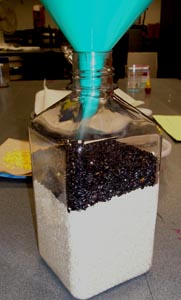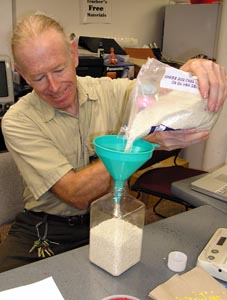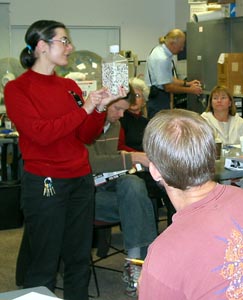
White nitrogen and dark oxygen rice model the atmosphere.
Earth Atmosphere Composition
It's a gas

White nitrogen and dark oxygen rice model the
atmosphere.
Introduction
You can use rice grains to model the composition of the atmosphere of the earth.
Material
Assembly
Weigh the empty bottle.
Use the funnel to fill the bottle of white rice about 90% full.

Filling the clear plastic bottle with white rice.
Take all the white rice out of the bottle and weigh it.
Remove 78% of the white rice and put it back into the bottle this represents the nitrogen in the earth's atmosphere.
Of the remaining 22% of the rice remove 21% and dye it blue. This will represent oxygen.
(To dye rice, place it in a disposable cup and pour in some food coloring, stir it with a stick. Then pour it out onto a metal sheet covered with paper towel to dry.)
You should have 1% of the weight of the original rice remaining. This is argon. Dye it yellow.
Count the number of grains of argon.
Take twice the weight of the argon and dye these green, this represents water vapor.
Count out rice grains in a number equal to 4% of the number of argon grains. This will be CO2 dye these grains red.
To Do and Notice
Pour the oxygen blue grains into the bottle on top of the nitrogen.
Pour the argon yellow grains in on top of the oxygen
Pour the water green grains in on top of the argon.
Put in 3/4 of the Carbon dioxide red grains.
This represents the composition of the earth's atmosphere in 1880.
Add the rest of the CO2 red grains one at a time.
This represents the atmosphere today.
Shake the bottle to mix up the grains.

Stephanie shows the finished atmosphere model.
What's Going On?
The water vapor, and carbon dioxide in this model are greenhouse gasses.
They form a small part of the atmosphere but an important part.
They are the major gasses that can absorb infrared radiation from the earth. Nitrogen and oxygen do not absorb infrared radiation.
As a result, when infrared radiation is emitted by the earth it does not go off into space, some of it is absorbed by the greenhouse gasses and then reemitted in a random direction.
Some of this radiation returns to the earth making it warmer.
|
Scientific Explorations with Paul Doherty |
|
21 November 2006 |